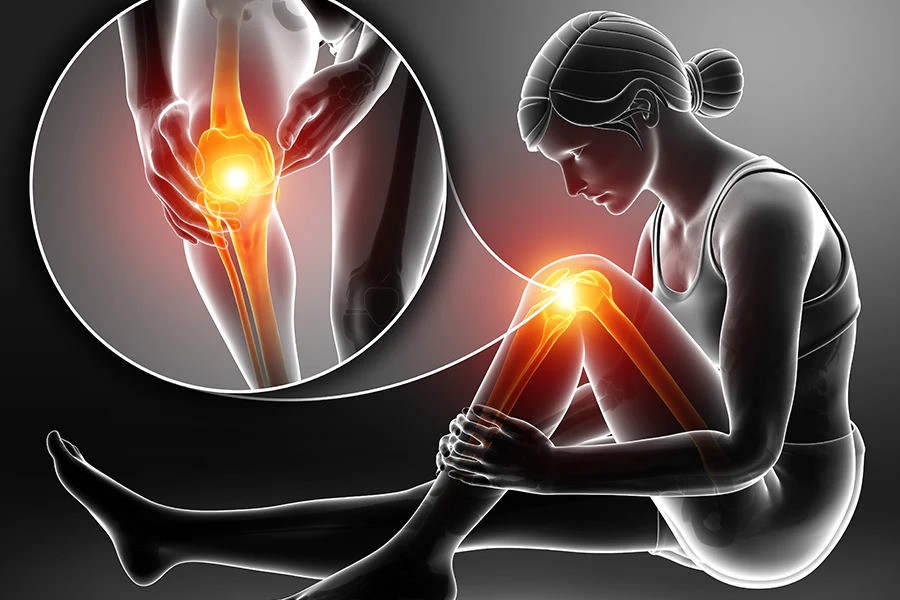Joints are essential components of our body, facilitating the movement of our limbs. When a person experiences pain in the joints, this condition is referred to as arthralgia. Joint pain can be so uncomfortable that it hinders daily activities. Today, we will discuss joint pain, its symptoms, and its diagnosis.
The skeletal system forms the framework of our body, and joints play a important role in enabling movement. There are three types of joints in our skeletal system: fibrous, cartilaginous, and synovial.
Types of Joints
- Fibrous Joints: Also known as sutures or synarthroses, fibrous joints are tightly connected by fibrous connective tissue, allowing very little to no movement. These usually immovable joints include the cranium in the skull, the joints between the teeth and the sockets in the jaw, and the joints between the bones of the lower leg. Sutures, found in the skull, and syndesmoses, which allow for a small amount of movement, provide structural support and protect vital organs and tissues, particularly in the skull.
- Cartilaginous Joints: In these joints, the bones are connected entirely by cartilage. They allow more movement than fibrous joints but less than the highly mobile synovial joints. There are two main types of cartilaginous joints:
- Synchondroses: In these joints, bones are joined by hyaline cartilage, typically found in the growth plates of children. As the individual matures, the cartilage is replaced by bone in a process called endochondral ossification.
- Symphyses: These joints consist of a pad or disk of fibrocartilage between the bones, providing strength with flexibility. Examples include the intervertebral discs of the spine and the pubic symphysis in the pelvis.
- Synovial Joints: These are the most common and highly movable type of joints in the human body. Synovial joints are characterized by a unique structure, including a smooth layer of hyaline cartilage covering the ends of the bones, an articular capsule enclosing the joint, synovial fluid lubricating the joint, and additional stability provided by ligaments. Examples include ball-and-socket joints like the shoulder and hip, hinge joints like the elbow and knee, and pivot joints such as the one between the first and second cervical vertebrae.
Causes of Joint Pain
Many conditions and factors can cause joint pain. Polyarthralgia refers to pain in multiple joints. Common causes of joint pain include:
- Injury: Injuries can result from excessive use or effort of the joints or from impacts causing fractures, sprains, or strains. For example, damage to the anterior cruciate ligament (ACL) is common in sports like soccer, basketball, or football.
- Viral Infection: Some infections, such as hepatitis C virus (HCV), can cause joint pain. HCV can lead to related rheumatic diseases, resulting in joint pain.
- Disease: Chronic autoimmune diseases like lupus can cause muscle and joint pain. Joint pain is often the first symptom of lupus, which occurs when the immune system attacks healthy tissue.
- Arthritis: Arthritis and arthralgia both describe joint pain, but arthritis involves distinct inflammation in the joint. Types of arthritis include osteoarthritis (OA), rheumatoid arthritis (RA), gout, and septic arthritis. OA results from cartilage loss, RA is an autoimmune response, gout involves uric acid crystallization, and septic arthritis typically results from a bacterial infection.
Symptoms and Diagnosis
Common symptoms accompanying joint pain include joint tenderness, stiffness, swelling, limited movement, weakness, and fatigue. Diagnosis usually involves a medical evaluation, including a physical examination and medical history review. Doctors may ask about the onset of pain, family history of joint disease, and inspect the joints’ range of motion. Laboratory tests, such as blood tests for rheumatoid factor, erythrocyte sedimentation rate, uric acid, C-reactive protein, and antinuclear antibodies, as well as imaging techniques like X-ray, MRI, ultrasound, and CT scans, may help with the diagnosis.
Treatment and Home Remedies
Joint pain can be alleviated by incorporating certain foods into your diet that have anti-inflammatory properties and support joint health. Fatty fish such as salmon and mackerel are rich in omega-3 fatty acids, which can help reduce inflammation and stiffness. Turmeric, known for its active compound curcumin, is also beneficial due to its anti-inflammatory and antioxidant effects. Berries like strawberries and blueberries, along with nuts and seeds such as walnuts and flaxseeds, provide antioxidants and omega-3s that support joint health. Incorporating these foods, along with ginger, leafy greens, olive oil, green tea, whole grains, and pineapple, can contribute to reducing joint pain and promoting overall joint health.
When to See a Doctor
It is important to seek medical attention if joint pain affects daily activities or causes concern. A doctor can diagnose the condition and provide appropriate treatment or referrals for specialist care.
Summary
Joint pain can result from various conditions, including injury and infection. While mild joint pain can often be managed with home remedies, medical treatment may be necessary for severe or persistent pain. Understanding the causes, symptoms, and diagnosis of joint pain can help in managing and alleviating this discomfort effectively.
Conclusion: Always consult with your doctor or a healthcare professional before making significant dietary changes for joint health. They can provide personalized guidance based on your medical history and current health status.
Note – If you have any health-related concerns, please call us at +91-9058577992 to receive free consultation from our experienced doctors. Thank you.
